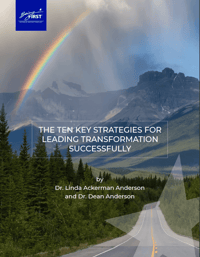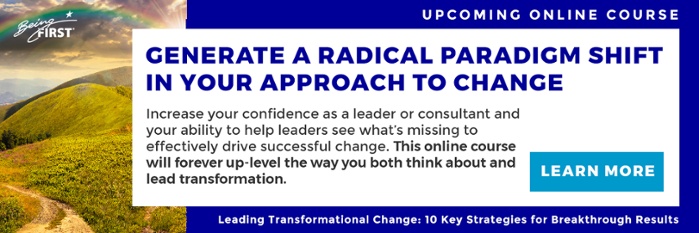You want transformation to be simple and fast? Or real and sustainable? For over forty years, we’ve guided executive leaders and experienced change consultants to succeed at organizational change and business transformation. We’ve seen what works and what fails… many times.
One of the biggest challenges to leaders launching transformational change is that they want it fast, cheap and simple. Who wouldn’t? However, this mindset and habitual demand is top of the list of what sets up transformation to fail. We’ll discuss the risks of simple and fast transformation and explore what’s required for real and sustainable transformation.
Often, leaders will engage change and project expertise that either doesn’t understand the real challenges of transformation or makes promises that never manifest. This costs millions of dollars and months of time—without ever seeing sustainable results.
Leaders need to understand what transformation requires and recognize that they need an approach to leading change that will deliver their transformational outcomes. To be blunt—fast and simple fails.
Understanding the Unique Demands of Transformational Change
Transformation is defined as a profound alteration of the organization. Its scope may encompass structure, strategy, products or services, business processes, or technology. These alterations are of such a magnitude that transformation also requires a profound change in culture, leadership and employee mindsets, relationships and behavior. The nature of transformation makes these non-negotiables. It’s as much about leaders and employees changing as it is about the organization changing. As Marilyn Ferguson once said, “If you continue to think the way you have always thought, you will continue to get what you have always gotten.” That won’t do in transformational change.
Successful change initiatives start at the top. Starting with executive leadership, people must evolve from the inside out, seeing how their old ways of thinking and acting will only perpetuate the very things they insist must transform. Therefore, leadership alignment to the personal and organizational change process, and leaders’ self-awareness, are essential ingredients to the success of business transformation.
Traditional approaches to manage organizational change do not adequately address the personal or cultural changes required for transformation to happen--and make it stick. Project management doesn’t accomplish it, and neither does change management. At best, change management is designed to manage stakeholder adoption of the changes leaders ask of them, but it does not address the leaders themselves. Often, change management plans are held secondary and subservient to project plans that are solely focused on getting the solution deployed. Culture, mindset, relationships and behavioral alterations may be noted, but rarely addressed with actions that are integrated into the overall project plan from the start.
Another unique dynamic of transformation is that the process begins before the future state solution is known. Advancing into the unknown is disconcerting for most leaders who are accustomed to having a clear plan and confident answers. Leaders may recognize the need for major change and may even have a vision of what the future needs to achieve. However, they must forge ahead before the future state is fully determined. Therefore, the process and the solution emerge as the change unfolds, requiring ongoing leadership and employee engagement, learning and course correction as both are shaped according to the best information known at any time. Because having a known destination is not possible from the beginning of a transformational change, designing and leading the emergent process is another reason why the personal development for leaders is so essential. They cannot lead transformation using tried-and-true controls and foregone conclusions.
Related Video:
Dr. Linda Ackerman Anderson and Dr. Dean Anderson discuss what transformation is and explore the critical areas of a transformation strategy that ensure success.
Case in Point
A large electric and gas utility recognized the need to transform into a masterful digital utility, one that would speed access to trustworthy information about the clear status of their aging infrastructures. They needed to proceed with the change effort before having a definitive picture of which aspects of the organization would be best suited for technological solutions or which kinds of technology they needed and how to deploy them. Their early attempts to put tablets into the hands of their field managers failed due to their lack of attention to their stakeholders’ mindsets, behaviors and entrenched cultural norms, and by imposing the new technologies on supervisors who were not yet ready or willing. The piecemeal approach and the lack of attention to their stakeholders’ needs were not working.
Organizing for the magnitude of this transformation required the executives to press pause, align as leaders, raise their awareness of how to deal with the magnitude of human and organizational change they aspired to create, and learn how to stay centered and work together in the face of complexity and the urgency to change. Their development began with deepening their understanding of what the transformation required of them and raising the capability of the executive team to consciously lead, plan, decide, relate and adapt to their journey.
The Risks of “Simple and Fast”
Too often, we hear leaders bemoan being told about the complexities of the changes they want to make. It doesn’t take long for many to impose their knee-jerk reaction of reverting to a project plan that is purely solution-focused, mandated on the stakeholders, and driven by a pre-determined timeline and budget. This does not work in transformational change. Calling a complex transformation a “project” so that it can be controlled and made to look simple is a costly illusion. It ignores the essential changes required of the leadership ranks. They need to ask for and count on relevant information from their stakeholders thus the best practice of high stakeholder engagement.
In addition, the transformational process needs to be supported to enact the best actions identified at any given time, and then promote the raising of new information that will help inform the solution and the process as it unfolds. We call this “getting smarter by the day.” Unfortunately, reliance on pre-determined scope, schedule, and budget prevents this essential dynamic from working. So do the cultural norms of “kill the messenger of bad news,” or “make a mistake and your career is over.” Course corrections must be welcomed and expected. They are the fastest way to the best outcome.
The other dynamic in transformation is that leaders do not have the answers they are accustomed to communicating early in a change process. This is unnerving both to them as leaders and to their people who depend on them for clear direction. This is where personal development becomes critical. Leaders need to learn to lead in the uncertain environment they must travel through, and the workforce needs to be engaged to offer their best thinking along the way, rather than passively wait to be told what to do. Neither of these changes is simple and fast. And both are absolutely essential to success.
What’s Required in Transformation and Change
Taking on a true transformation to achieve successful and sustainable outcomes requires leaders to invest in personal and professional development. Collectively, they must determine where they want to go and align to that vision and the process to get there. They need an accurate assessment of their current reality against their vision, one that includes an assessment not only of the organization, but of their culture, mindsets and behaviors. From there, they can determine their critical “breakthroughs” or targets they need to achieve, and develop a transformational strategy that accounts for a people-centric organizational change approach. Implementation of their strategy requires close oversight and genuine openness to learn and adjust. Staying the course is essential, until they have attained their milestones and can assess the lasting value of the transformation. Adoption and sustainment of business benefits, and a workforce that is skilled and hungry to succeed, are the ultimate goals.
Given the urgency of the business environment today, we must point out that none of this automatically requires years. The true time needed depends on the magnitude of change in scope and the readiness of the leaders and organization to take on the challenge of transformation. The more that leaders and workers align to take it on collectively, the faster the process and the higher the results.
Successful transformation leaders take heed of the habitual reaction of “simple and fast.” If you want to transform, commit to the development that will mobilize and ensure your success.
Related eBook:
The Ten Key Strategies for Leading Transformation

Through 40 years of observing and supporting large-scale change and transformation in Fortune 500, government, global NGOs and public service organizations, we’ve identified these ten Best Practice strategies for leading transformation successfully.
Please complete the form to download your eBook:
Related Webinar:
Go Beyond Change Management: What it Takes


